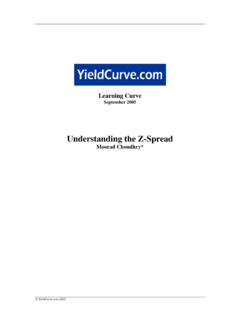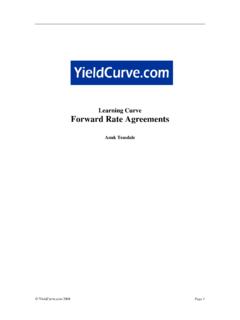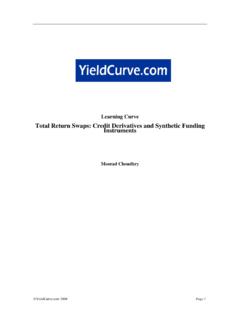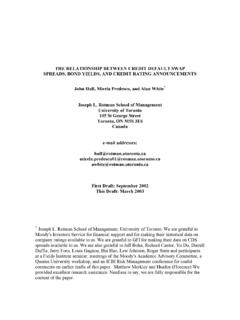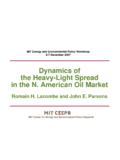Transcription of Relative value analysis: calculating bond spreads Moorad ...
1 Relative value analysis : calculating bond spreads Moorad Choudhry January 2006 Relative value analysis : bond spreads Moorad Choudhry Investors measure the perceived market value , or Relative value , of a corporate bond by measuring its yield spread Relative to a designated benchmark. This is the spread over the benchmark that gives the yield of the corporate bond . A key measure of Relative value of a corporate bond is its swap spread. This is the basis point spread over the interest-rate swap curve, and is a measure of the credit risk of the bond .
2 In its simplest form, the swap spread can be measured as the difference between the yield-to-maturity of the bond and the interest rate given by a straight-line interpolation of the swap curve. In practice traders use the asset-swap spread and the Z-spread as the main measures of Relative value . The government bond spread is also used. In addition, now that the market in synthetic corporate credit is well established, using credit derivatives and credit default swaps (CDS), investors consider the Cash-CDS spread as well, which is known as the basis.
3 Credit derivatives are introduced in the author s book on structured credit products (Choudhry 2004b) as well as his paper on the CDS basis (Choudhry 2004a). The spread that is selected is an indication of the Relative value of the bond , and a measure of its credit risk. The greater the perceived risk, the greater the spread should be. This is best illustrated by the credit structure of interest rates, which will (generally) show AAA- and AA-rated bonds trading at the lowest spreads and BBB- , BB- and lower-bonds trading at the highest spreads .
4 bond spreads are the most commonly-used indication of the risk-return profile of a bond . In this section we consider the Treasury spread, asset swap spread, Z-spread and basis. Swap spread and Treasury spread A bond s swap spread is a measure of the credit risk of that bond , Relative to the interest-rate swaps market. Because the swaps market is traded by banks, this risk is effectively the interbank market, so the credit risk of the bond over-and-above bank risk is given by its spread over swaps. This is a simple calculation to make, and is simply the yield of the bond minus the swap rate for the appropriate maturity swap.
5 Figure 1 shows Bloomberg page IRSB for Pounds sterling as at 10 August 2005. This shows the GBP swap curve on the left-hand side. The right-hand side of the screen shows the swap rates spread over UK gilts. It is the spread over these swap rates that would provide the simplest Relative value measure for corporate bonds denominated in GBP. If the bond has an odd maturity, say years, we would interpolate between the five-year and six-year swap rates. 2006 Page 2 of 10 Figure 1 Bloomberg page IRSB for Pounds sterling, showing GBP swap rates and swap spread over UK gilts Bloomberg All rights reserved.
6 Reprinted with permission. The spread over swaps is sometimes called the I-spread. It has a simple relationship to swaps and Treasury yields, shown here in the equation for corporate bond yield, Y = I + S+ T where Y is the yield on the corporate bond I is the I-spread or spread over swap S is the swap spread T is the yield on the Treasury security (or an interpolated yield). In other words, the swap rate itself is given by T + S. The I-spread is sometimes used to compare a cash bond with its equivalent CDS price, but for straightforward Relative value analysis is usually dropped in favour of the asset-swap spread, which we look at later in this section.
7 2006 Page 3 of 10Of course the basic Relative value measure is the Treasury spread or government bond spread. This is simply the spread of the bond yield over the yield of the appropriate government bond . Again, an interpolated yield may need to be used to obtain the right Treasury rate to use. The bond spread is given by: BS = Y T. Using an interpolated yield is not strictly accurate because yield curves are smooth in shape and so straight-line interpolation will produce slight errors.
8 The method is still commonly used though. Asset-swap spread An asset swap is a package that combines an interest-rate swap with a cash bond , the effect of the combined package being to transform the interest-rate basis of the bond . Typically, a fixed-rate bond will be combined with an interest-rate swap in which the bond holder pays fixed coupon and received floating coupon. The floating-coupon will be a spread over Libor (see Choudhry et al 2001). This spread is the asset-swap spread and is a function of the credit risk of the bond over and above interbank credit Asset swaps may be transacted at par or at the bond s market price, usually par.
9 This means that the asset swap value is made up of the difference between the bond s market price and par, as well as the difference between the bond coupon and the swap fixed rate. The zero-coupon curve is used in the asset swap valuation. This curve is derived from the swap curve, so it is the implied zero-coupon curve. The asset swap spread is the spread that equates the difference between the present value of the bond s cashflows, calculated using the swap zero rates, and the market price of the bond .
10 This spread is a function of the bond s market price and yield, its cashflows and the implied zero-coupon interest Figure 2 shows the Bloomberg screen ASW for a GBP-denominated bond , GKN Holdings 7% 2012, as at 10 August 2005. We see that the asset-swap spread is basis points. This is the spread over Libor that will be received if the bond is purchased in an asset-swap package. In essence the asset swap spread measures a difference between the market-price of the bond and the value of the bond when cashflows have been valued using zero-coupon rates.

